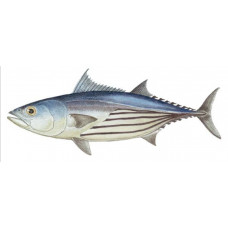Latin name
Katsuwonus pelamis
Other names
Skipjack, ocean bonito, arctic bonito, striped tuna, watermelon tuna; French: benite à ventre raye; Hawaiian: aku; Italian: tonnetto striato; Japanese: katsuo; Portuguese: gaiado, listão, listado; Spanish: bonito ártico, barrilete, listado
Identification
The body is typical of tuna - spindle-shaped, elongated, rounded in cross-section. The presence of stripes on the abdomen and the absence of markings on the back are enough to distinguish skipjack tuna from all similar species. The upper part of the fish is dark purple-blue, while the lower flanks and belly are silvery and have four to six prominent dark longitudinal stripes. The first dorsal fin has 14 to 16 spines, and the pectoral and pelvic fins are short. The body is without scales except for the corset and lateral line. This fish has no swim bladder. There is a strong lateral keel on each side of the caudal fin. Each jaw has approximately 30-40 small conical teeth. The teeth are smaller and more numerous than those of the bonito, and do not resemble the triangular, compressed teeth of the mackerel. There are 53 to 63 gill rakers on the first arch, which is more than in any other tuna species except the slender tuna (Allothunnus).
Distribution
Widespread in tropical and temperate waters of all oceans. Absent in the Black Sea. Most are found throughout the tropical Atlantic as far south as Argentina, and in the summer months may go as far north as Cape Cod, Massachusetts.
Habitat
Skipjack tuna is cosmopolitan in tropical and subtropical seas, usually in deep coastal and oceanic waters. A pelagic, migratory, deep-water species, it can form shoals of 50,000 or more individuals. Non-riot oceanic species. Occurs in the range of surface ocean temperatures - from 14.7 to 30 °C. It is most abundant in areas with surface temperatures of 20-25 °C, in areas of rising water masses, convergence, at the boundaries of cold and warm water masses. It is found from the ocean surface to a depth of 260 m.
Size
Skipjack tuna can reach a maximum length of 40 to 45 inches, but they are usually 16 to 28 inches long and weigh 5 to 15 pounds. The world record for catches on all tackle is 45 pounds 4 ounces. They can live up to 12 years. Striped tuna grow quite quickly. The first year of life (depending on habitat area) is 27-441 cm long, then growth slows down (growth of 7 to 14 cm per year). In the vicinity of Cuba by age 5, the length of 76 cm in the Gulf of Guinea - 69.1 cm in the Indian Ocean in the 3rd year of life has an average length of 58 cm.
Life history and Behavior
In the western Atlantic Ocean, skipjack tuna are often found together with blackfin tuna. Skipjack tuna reach sexual maturity at 18 to 20 inches in length. Spawning occurs in spurts throughout the year in tropical waters and from spring to early fall in subtropical waters.
Food and feeding habits
This gregarious, fast-swimming fish feeds near the surface, and its diet consists of herring, squid, small mackerel and bonito, lanternfish, shrimp, and crustaceans. It feeds most actively in the morning and evening hours.
Reproduction
Spawning takes place in portions, the number of portions ranging from 3 to 4. It occurs in the surface layers of water at a temperature of at least 24 °C. In tropical waters, it lasts throughout the year (in the equatorial zone), in the subtropics - in the spring and summer. Fish become sexually mature at a length of 42-45 cm. The fecundity of fish 41-87 cm in length ranges from 80 thousand to 2 million eggs in one breeding season.
| Classification | |
| Phylum | Chordata |
| Class | Actinopterygii |
| Squad | Scombriformes |
| Family | Scombridae |
| Genus | Katsuwonus |
| Species | K. pelamis |
| Features | |
| Conservation status | Least Concern |
| Habitat | Pelagic |
| Life span, years | 12 |
| Maximum body weight, kg | 34.5 |
| Maximum length, cm | 100 |
| Sailing speed, m/s | No information |
| Threat to people | Edible |
| Way of eating | Predator |



